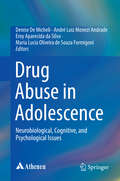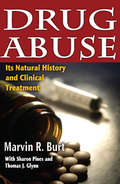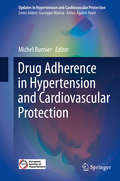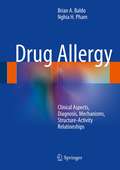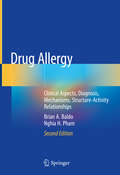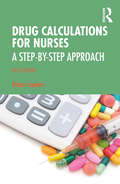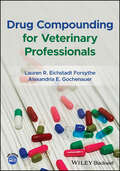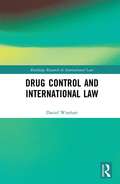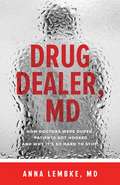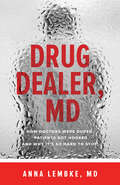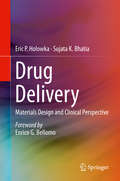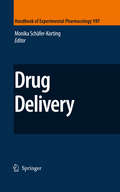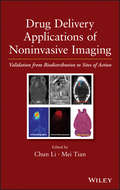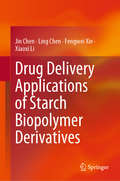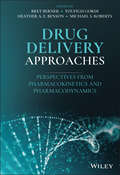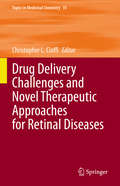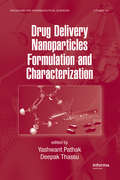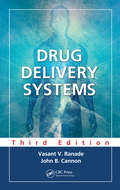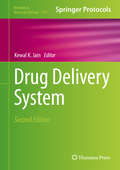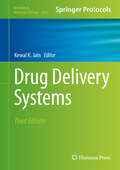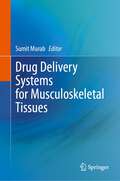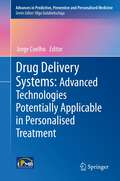- Table View
- List View
Drug Abuse in Adolescence
by Denise Micheli André Luiz Monezi Andrade Eroy Aparecida da Silva Maria Lucia Oliveira de Souza-FormigoniFocusing on two central themes--the psychobiological evolution from youth to adult and the effects of drugs on the developing central nervous system--this important reference elucidates the mechanisms of chemical dependency in adolescents. Its multidisciplinary coverage analyzes addiction across major domains of human functioning against the backdrop of hormonal, cognitive, and other changes that accompany the transition to adulthood. Chapters discuss legal as well as illicit drugs, examine age-related social contexts, and present the latest findings on links between drug use and mental disorders. Throughout, the contributors make clear that education is more valuable to understanding--and preventing--substance abuse than are prohibition and zero-tolerance thinking. Included among the topics: Cognitive development, learning, and drug use. Neurobiology of the action of drugs of abuse. Findings in adolescents with substance dependence based on neuroimaging tests. Alcohol abuse in adolescents: relevance of animal models. Effects of chronic drug abuse on the chronobiology of sleep in adolescents. Neurological and cognitive disorders arising from the chronic use of drugs of abuse. The multiple lenses for understanding its subject and the sensitivity with which causal nuances are treated make Neuroscience of Drug Abuse in Adolescence an invaluable resource for clinical and child psychologists, psychiatrists, social workers, and addiction counselors.
Drug Abuse: Its Natural History and Clinical Treatment
by Marvin R. Burt Sharon Pines Thomas J. GlynnThe success or failure of drug treatment programs have long been evaluated by assessing the clients' progress while in treatment and their status upon completion. This approach does not provide a complete assessment or an adequate picture of treatment outcomes over time. A comprehensive evaluation of the success or failure of treatment should also include client status in the years following treatment for a fair assessment of the long-term efficacy of any drug-treatment program. What happens to former clients who left treatment? What influence did the treatment have on their lives? These are the questions that Marvin R. Burt seeks to answer with the follow-up studies included in this book. By selecting samples of former clients treated by two of the largest drug treatment agencies in the U.S. and control groups, Burt compares client behavior in terms of drug abuse, criminal activity, and socioeconomic productivity before, immediately following, and well after treatment. The findings in this book challenge many common assumptions about drug treatment programs. Burt finds larger than expected positive behavioral changes in clients regardless of treatment duration or type, and demographic or background characteristics. Whether the results are attributable to the clients' maturation, commitment to change, or a reduction in the availability of drugs, the positive results of treatment are encouraging. This volume provides valuable insight into the natural history of drug abuse and outcomes for client groups.
Drug Adherence in Hypertension and Cardiovascular Protection (Updates in Hypertension and Cardiovascular Protection)
by Michel BurnierThis book provides a critical and comprehensive review of the methodologies available for measuring drug adherence in clinical practice, including those relying on emerging technologies. The authors discuss the risk factors of non-adherence and shed light on how to identify patients at risk of poor adherence. Drug therapies in chronic diseases rely heavily on the patient's adherence, since drugs that are not taken are ineffective and leave the patient at high risk of developing clinical complications. Given the absence of new drugs for the treatment of hypertension, drug adherence is particularly important in these patients to improve blood pressure control. The book further investigates a new aspect, namely the importance of drug adherence in clinical trials and studies and draws attention to the limits of developing drugs without significant information on drug adherence. Several chapters are dedicated to the importance of adherence in specific forms of hypertension, such as resistant hypertension, dyslipidemia and hypertension associated with cardiovascular risk. As experts confronted with drug adherence in their daily practice, the authors analyse the real effectiveness of several interventions aimed at improving drug adherence and put particular emphasis on the importance of an interdisciplinary approach involving nurses and pharmacists. The volume also includes a careful analysis of the health and economic impact of poor adherence. The book is aimed at physicians, pharmacists, students and all health professionals dealing not only with hypertension or dyslipidemia, but also with chronic asymptomatic diseases such as diabetes, HIV or chronic respiratory diseases.
Drug Allergy: Clinical Aspects, Diagnosis, Mechanisms, Structure-Activity Relationships
by Brian A. Baldo Nghia H PhamThe variety of chemically diverse pharmacological agents administered to patients is large and continues to expand and with every new drug released, there is always potential for adverse reactions, some of them allergic. With its roots in immunology and pharmacology, the science of drug allergy is becoming better understood and applied as its importance is increasingly recognized throughout the many branches of medicine. Drug Allergy: Clinical Aspects, Diagnosis, Mechanisms, Structure-Activity Relationships sheds new light on this field. Comprehensive in design, this authoritative title identifies the most important culprit drugs implicated in immediate and delayed drug hypersensitivities and offers up-to-date information on classifications, diagnoses, underlying mechanisms and structure-activity relationships. Chapters dealing with the molecular and cellular mechanisms of drug hypersensitivities, non-immune-mediated sensitivities and diagnostic methods are presented as introductory material for in-depth treatises on the β-lactam antibiotics, other antibiotics and antimicrobials, drugs used in anesthesia and surgery, opioid analgesics, corticosteroids, monoclonal antibodies and other biologics, drugs used in chemotherapy, proton pump inhibitors, iodinated and gadolinium-based contrast media and non-steroidal anti-inflammatory drugs. In addition to being of immense value to clinicians, other health care professionals and researchers, this title will prove invaluable for those taking undergraduate and graduate courses in science and will also serve as a useful text for students of medicine, pharmacy, nursing and dentistry.
Drug Allergy: Clinical Aspects, Diagnosis, Mechanisms, Structure-Activity Relationships
by Brian A. Baldo Nghia H. PhamThe second edition of this book spans the broad range of modern therapeutic drugs, from small molecules to biologic recombinant proteins. It offers a comprehensive review of the classification and description of different drug-induced systemic and cutaneous hypersensitivities; an up-to-date coverage of individual culprit drugs in each group of therapeutics; the diagnosis and mechanisms of reactions; and important structure-activity relationships. New content expands to two areas of drug allergy that have recently experienced explosive growth: biological therapies and new targeted chemotherapies. Other new and expanded chapters address antimicrobials; drugs used in anesthesia and surgery; opioids; non-targeted anti-cancer drugs; vaccines; and newly understood reaction mechanisms.This new edition includes photographs of a wide variety of cutaneous manifestations that will be of use to other clinicians as well as allergists and dermatologists. In addition to its wide clinical emphasis, the book’s mechanistic and structure-activity detail will provide valuable background for researchers and investigators in universities, medical research institutes, drug companies, and regulatory agencies. The second edition of Drug Allergy is an essential reference for practitioners across the medical disciplines from specialist clinicians, surgeons, GPs, residents, and medical students to nurses, pharmacists, dentists, and those taking undergraduate and graduate courses in the biomedical sciences.
Drug Calculations for Nurses: A Step-by-Step Approach
by Robert LaphamThis new edition of Drug Calculations for Nurses teaches healthcare professionals how to perform drug calculations with confidence and competence. It provides step-by-step guidance to carry out accurate drug calculations, with units and drug strengths clearly explained. This bestselling pocket-size book begins with the basic mathematical skills required to perform calculations, including tips on estimating answers. It then covers drug strengths and concentrations, dosage calculations, IV infusion therapies, and pharmacodynamics and pharmacokinetics. Separate chapters focus on children, adults and the elderly, addressing specific challenges encountered in these populations, with new content on pregnancy, and renal and liver function. Helpful worked examples, key points, and objectives are included in every chapter, and this new edition includes more calculations for prescribing and patient-focused scenarios. The companion website, www.drugcalcsnurses.co.uk, provides a comprehensive test bank, with a pre-test and revision test to identify strengths and weaknesses, along with additional practice questions for readers to test themselves on. Designed for students and practitioners in nursing, midwifery and allied health, this textbook enables readers to improve their numeracy skills for clinical practice and develop their understanding of the broader context for these calculations.
Drug Compounding for Veterinary Professionals
by Lauren R. Eichstadt Forsythe Alexandria E. GochenauerDrug Compounding for Veterinary Professionals Safely, effectively, and legally tailor drug treatments to the needs of your specific veterinary patients with this accessible guide Drug Compounding for Veterinary Professionals provides an accessible, easy-to-use guide to all aspects of prescribing individualized mixtures of medications in veterinary practice. Its emphasis on practical knowledge and its discussion of both in-house and external options make it a comprehensive introduction to using compounded medications in animals. It guides practitioners through every step of the process, from formulating a compound to working with outside pharmacists. The book presents guidance on how to get more information on current regulations, consider the risks and benefits, develop formulations, and more. Drug Compounding for Veterinary Professionals readers will also find: Figures and line drawings illustrating effective compounding techniques and concepts An emphasis on practical knowledge for clinical use Answers to frequently asked questions about drug compounding Drug Compounding for Veterinary Professionals is essential for any veterinary practitioner, veterinary pharmacologist, or student looking to understand this crucial component of patient care.
Drug Control and Human Rights in International Law
by Schabas Lines Richard Schabas William A. Richard LinesHuman rights violations occurring as a consequence of drug control and enforcement are a growing concern, and raise questions of treaty interpretation and of the appropriate balancing of concomitant obligations within the drug control and human rights treaty regimes. Tracing the evolution of international drug control law since 1909, this book explores the tensions between the regime's self-described humanitarian aspirations and its suppression of a common human behaviour as a form of 'evil'. Drawing on domestic, regional and international examples and case law, it posits the development of a dynamic, human rights-based interpretative approach to resolve tensions and conflicts between the regimes in a manner that safeguards human rights. Highlighting an important and emerging area of human rights inquiry from an international legal perspective, this book is a key resource for those working and studying in this field.
Drug Control and International Law (Routledge Research in International Law)
by Daniel WisehartThis book provides for an extensive legal analysis of the international drug control system in light of the growing challenges and criticism that this system faces. In the current debate on global drug policy, the central pillars of the international drug control system – the UN Drug Conventions as well as its institutions – are portrayed as outdated, suppressive and seen as an obstacle to necessary changes. The book’s objective is to provide an in-depth and positivist insight into drug control’s present legal framework and thus provide for a better understanding of the normative assumptions upon which drug control is currently based. This is attained by clarifying the objectives of the international drug control system and the premises by which these objectives are to be achieved. The objective of the current global framework of international drug control is the limitation of drugs to medical and scientific purposes. The meaning of this objective and its concrete implications for States’ parties as well as its problems from the perspective of other regimes of international law, most notably international human rights law, are extensively analysed. Additionally, the book focuses on how the international drug control system attempts to reach the objective of confining drugs to medical and scientific purposes, i.e. by setting up a universal system that exercises a rigid control on drug supply. The consequences of this heavy focus on the reduction of drug supply are outlined, and the book concludes by making suggestions on how the international drug control system could be reformed in the near future in order to better meet the existing challenges. The analysis occurs from a general international law perspective. It aims to map the international drug control system within a wider context of international law and to understand whether the problems that the international drug control system faces are exemplary for the difficulties that institutionalized systems of global scope face in the twenty-first century.
Drug Dealer, MD: How Doctors Were Duped, Patients Got Hooked, and Why It's So Hard to Stop
by Anna LembkeThree out of four people addicted to heroin probably started on a prescription opioid, according to the director of the Centers for Disease Control and Prevention. In the United States alone, 16,000 people die each year as a result of prescription opioid overdose. But perhaps the most frightening aspect of the prescription drug epidemic is that it's built on well-meaning doctors treating patients with real problems. In Drug Dealer, MD, Dr. Anna Lembke uncovers the unseen forces driving opioid addiction nationwide. Combining case studies from her own practice with vital statistics drawn from public policy, cultural anthropology, and neuroscience, she explores the complex relationship between doctors and patients, the science of addiction, and the barriers to successfully addressing drug dependence and addiction. Even when addiction is recognized by doctors and their patients, she argues, many doctors don't know how to treat it, connections to treatment are lacking, and insurance companies won't pay for rehab. Full of extensive interviews-with health care providers, pharmacists, social workers, hospital administrators, insurance company executives, journalists, economists, advocates, and patients and their families- Drug Dealer, MD, is for anyone whose life has been touched in some way by addiction to prescription drugs. Dr. Lembke gives voice to the millions of Americans struggling with prescription drugs while singling out the real culprits behind the rise in opioid addiction: cultural narratives that promote pills as quick fixes, pharmaceutical corporations in cahoots with organized medicine, and a new medical bureaucracy focused on the bottom line that favors pills, procedures, and patient satisfaction over wellness. Dr. Lembke concludes that the prescription drug epidemic is a symptom of a faltering health care system, the solution for which lies in rethinking how health care is delivered.
Drug Dealer, MD: How Doctors Were Duped, Patients Got Hooked, and Why It’s So Hard to Stop
by Anna LembkeThe disturbing connection between well-meaning physicians and the prescription drug epidemic.Three out of four people addicted to heroin probably started on a prescription opioid, according to the director of the Centers for Disease Control and Prevention. In the United States alone, 16,000 people die each year as a result of prescription opioid overdose. But perhaps the most frightening aspect of the prescription drug epidemic is that it’s built on well-meaning doctors treating patients with real problems.In Drug Dealer, MD, Dr. Anna Lembke uncovers the unseen forces driving opioid addiction nationwide. Combining case studies from her own practice with vital statistics drawn from public policy, cultural anthropology, and neuroscience, she explores the complex relationship between doctors and patients, the science of addiction, and the barriers to successfully addressing drug dependence and addiction. Even when addiction is recognized by doctors and their patients, she argues, many doctors don’t know how to treat it, connections to treatment are lacking, and insurance companies won’t pay for rehab. Full of extensive interviews—with health care providers, pharmacists, social workers, hospital administrators, insurance company executives, journalists, economists, advocates, and patients and their families—Drug Dealer, MD, is for anyone whose life has been touched in some way by addiction to prescription drugs. Dr. Lembke gives voice to the millions of Americans struggling with prescription drugs while singling out the real culprits behind the rise in opioid addiction: cultural narratives that promote pills as quick fixes, pharmaceutical corporations in cahoots with organized medicine, and a new medical bureaucracy focused on the bottom line that favors pills, procedures, and patient satisfaction over wellness. Dr. Lembke concludes that the prescription drug epidemic is a symptom of a faltering health care system, the solution for which lies in rethinking how health care is delivered.
Drug Delivery
by Sujata K. Bhatia Eric P. HolowkaCurrent pharmaceutical and clinical approaches to the treatment of disease suffer from the inherent limitations in the specialization of drugs introduced to physiological systems. The interface of clinical and material sciences has allowed for a broad spectrum of creative approaches with the potential to alleviate these shortcomings. However, the synergy of these disciplines also presents problems in which nascent technology lacks the necessary evaluation within its intended clinical environment. Given the growing potential for materials science to address a number of unanswered therapeutic needs, it remains even more pressing to validate emerging drug delivery technologies in actual clinical environments. Drug Delivery: Materials Design and Clinical Perspective addresses the core fundamentals of drug delivery using material science and engineering principles, and then applies this knowledge using prominent examples from both the scientific literature and clinical practice. Each chapter focuses on a specific drug delivery technology, such as controlled-release materials, thin-film materials, or smart materials. Within each chapter, an initial section on "Engineering Concepts" reviews the relevant fundamental principles that guide rational design. The following section on "Materials Design" discusses how the design process applies engineering concepts for use in physiological systems. A third section on "Implementation" discusses current approaches in the literature which have demonstrated effective drug delivery in controlled environments. Finally, each chapter contains several sections on "Clinical Applications" which describe the validity of materials approaches from a clinical perspective; these sections review the safety and efficacy of drug delivery systems for specific, compelling medical applications. The book thereby bridges materials science with clinical medicine, and provides the reader with a bench-to-bedside view of novel drug delivery systems. · Provides a comprehensive description of drug delivery systems from a materials perspective · Includes a wide-ranging discussion of clinical applications of drug delivery systems · Presents separate chapters on controlled release materials, thin film materials, self-microemulsifying materials, smart materials, etc. · Covers fundamental engineering principles, rational materials design, implementation testing, and clinical applications for each material type
Drug Delivery
by Monika Schäfer-KortingIn the view of most experts pharmacology is on drugs, targets, and actions. In the context the drug as a rule is seen as an active pharmaceutical ingredient and not as a complex mixture of chemical entities of a well defined structure. Today, we are becoming more and more aware of the fact that delivery of the active compound to the target site is a key. The present volume gives a topical overview on various modern approaches to drug targeting covering today's options for specific carrier systems allowing successful drug treatment at various sites of the body difficult to address and allowing to increase the benefit-risk-ratio to the optimum possible.
Drug Delivery Applications of Noninvasive Imaging
by Mei Tian Chun LiCost-effective strategies for designing novel drug delivery systems that target a broad range of disease conditionsIn vivo imaging has become an important tool for the development of new drug delivery systems, shedding new light on the pharmacokinetics, biodistribution, bioavailability, local concentration, and clearance of drug substances for the treatment of human disease, most notably cancer. Written by a team of international experts, this book examines the use of quantitative imaging techniques in designing and evaluating novel drug delivery systems and applications.Drug Delivery Applications of Noninvasive Imaging offers a full arsenal of tested and proven methods, practices and guidance, enabling readers to overcome the many challenges in creating successful new drug delivery systems. The book begins with an introduction to molecular imaging. Next, it covers:In vivo imaging techniques and quantitative analysisImaging drugs and drug carriers at the site of action, including low-molecular weight radiopharmaceuticals, peptides and proteins, siRNA, cells, and nanoparticlesApplications of imaging techniques in administration routes other than intravenous injection, such as pulmonary and oral deliveryTranslational research leading to clinical applicationsImaging drug delivery in large animal modelsClinical applications of imaging techniques to guide drug development and drug deliveryChapters are based on a thorough review of the current literature as well as the authors' firsthand experience working with imaging techniques for the development of novel drug delivery systems.Presenting state-of-the-technology applications of imaging in preclinical and clinical evaluation of drug delivery systems, Drug Delivery Applications of Noninvasive Imaging offers cost-effective strategies to pharmaceutical researchers and students for developing drug delivery systems that accurately target a broad range of disease conditions.
Drug Delivery Applications of Starch Biopolymer Derivatives (SpringerBriefs in Molecular Science)
by Jin Chen Xiaoxi Li Ling Chen Fengwei XieThis book summarizes the recent advances in applications of starch in state-of-the-art drug carriers (hydrogel, micro- and nano-particulate carriers) with stimulus-responsive and target-specific properties. It also highlights the role of starch and its derivatives in transmucosal administration to improve the bioavailability of drugs. Further, it outlines the principles of effective, advanced, starch-based drug delivery systems and illustrates how these principles are key to the development of future drug delivery strategies. This interesting reference resource is useful for students, researchers and engineers in the fields of carbohydrate chemistry, polymer sciences and drug delivery.
Drug Delivery Approaches: Perspectives from Pharmacokinetics and Pharmacodynamics
by Bret BernerExplore this comprehensive discussion of the application of physiologically- and physicochemical-based models to guide drug delivery edited by leading experts in the field Drug Delivery Approaches: Perspectives from Pharmacokinetics and Pharmacodynamics delivers a thorough discussion of drug delivery options to achieve target profiles and approaches as defined by physical and pharmacokinetic models. The book offers an overview of drug absorption and physiological models, chapters on oral delivery routes with a focus on both PBPK and multiple dosage form options. It also provides an explanation of the pharmacokinetics of the formulation of drugs delivered by systemic transdermal routes. The distinguished editors have included practical and accessible resources that address the biological and delivery approaches to pulmonary and mucosal delivery of drugs. Emergency care settings are also described, with explorations of the relationship between parenteral infusion profiles and PK/PD. The future of drug delivery is addressed via discussions of virtual experiments to elucidate mechanisms and approaches to drug delivery and personalized medicine. Readers will also benefit from the inclusion of: A thorough introduction to the utility of mathematical models in drug development and delivery An exploration of the techniques and applications of physiologically based models to drug delivery Discussions of oral delivery and pharmacokinetic models and oral site-directed delivery A review of integrated transdermal delivery and pharmacokinetics in development An examination of virtual experiment methods for integrating pharmacokinetic, pharmacodynamic, and drug delivery mechanisms Alternative endpoints to pharmacokinetics for topical delivery Perfect for researchers, industrial scientists, graduate students, and postdoctoral students in the area of pharmaceutical science and engineering, Drug Delivery Approaches: Perspectives from Pharmacokinetics and Pharmacodynamics will also earn a place in the libraries of formulators, pharmacokineticists, and clinical pharmacologists.
Drug Delivery Challenges and Novel Therapeutic Approaches for Retinal Diseases (Topics in Medicinal Chemistry #35)
by Christopher L. CioffiThis book reviews the current state of ocular drug therapy and future therapeutic opportunities for a wide variety of conditions, including Age-related Macular Degeneration, Diabetic Retinopathy and Macular Edema, Glaucoma, and Inherited Retinal Diseases.Retinal diseases are major contributors to moderate or severe vision impairment in adults aged 50 years and older. The respective patient populations for many of these indications is expected to significantly increase as the world population continues to grow older. An improved understanding of the etiological underpinnings of ocular degenerative diseases over the past decade has significantly bolstered ophthalmic drug discovery.In this volume, contributions from leading experts explore the unique challenges faced for ocular drug discovery and delivery providing the reader with detailed information on ocular pharmacokinetics, in vitro, ex vivo and in vivo models for retinal disease pathology and emerging gene therapy treatments. The book is intended for all researchers and clinicians who wish to increase their knowledge on the latest findings in ocular drug therapy.
Drug Delivery Nanoparticles Formulation and Characterization (Drugs and the Pharmaceutical Sciences)
by Yashwant Pathak Deepak ThassuExploring fundamental concepts, Drug Delivery Nanoparticles Formulation and Characterization presents key aspects of nanoparticulate system development for various therapeutic applications and provides advanced methods used to file for regulatory approval.This comprehensive guide features:Process Analytical Techniques (PAT) used in manufacturing Na
Drug Delivery Strategies in Neurological Disorders: Challenges and Opportunities
by Hitesh Kulhari Awanish MishraThis book comprehensively reviews the recent progress in their pathogenesis and management approaches for neurological disorders. It focuses on understanding the molecular mechanism, pathology, novel nanotechnology-based approaches against stroke, Alzheimer’s disease, Parkinson disease, Huntington’s disease, Multiple sclerosis, and Epilepsy. The book provides the basic understanding about the development and progression of these diseases, and recent pharmacotherapeutic approaches for their management. It also discusses challenges in drug development for neurological disorders, including preclinical models of disorders, the need for drugs to cross the blood-brain-barrier, and limited understanding of relevant pathophysiology. The book also focuses on different conventional and novel strategies for drug delivery in neurological disorders. Towards the end, the book reviews the applications of nanotechnology for the diagnosis of neurological disorders. One of the chapters is focused onthe role of herbal actives in the treatment of neurological disorders. Finally, a chapter is included on nanotechnology-based approaches for diagnosis of neurological disorders. This book is a useful resource for students and researchers of pharmaceutical sciences, life sciences, material sciences, and nanosciences.
Drug Delivery Systems
by Vasant V. Ranade John B. CannonDrug delivery technologies represent a vast, vital area of research and development in pharmaceuticals. The demand for innovative drug delivery systems continues to grow, driving a variety of new developments. Drug Delivery Systems, Third Edition provides a comprehensive review of the latest research and development on drug delivery systems.Coverag
Drug Delivery Systems
by Kewal K. JainIn this concise and systematic book, a team of experts select the most important, cutting-edge technologies used in drug delivery systems. They take into account significant drugs, new technologies such as nanoparticles, and therapeutic applications. The chapters present step-by-step laboratory protocols following the highly successful Methods in Molecular BiologyTM series format, offering readily reproducible results vital for pharmaceutical physicians and scientists.
Drug Delivery Systems (Methods in Molecular Biology #2059)
by Kewal K. JainThis third edition volume expands on the previous editions with a discussion of new and updated methods used to study drug delivery. Chapters cover topics such as drug delivery in cancer and intrathecal delivery of analgesics in humans. The increasing role of nanobiotechnology is reflected in eight of the sixteen chapters that include synthesis of gold nanoparticles; targeted siRNA delivery; and lipid nanocarriers. Written in the highly successful Methods in Molecular Biology series format, chapters include introductions to their respective topics, lists of the necessary materials and reagents, step-by-step, readily reproducible laboratory protocols, and tips on troubleshooting and avoiding known pitfalls.Authoritative and thorough, Drug Delivery Systems: Methods and Protocols, Third Edition is a valuable resource for scientists working in industry or academia, and physicians involved in research and clinical care of patients.
Drug Delivery Systems for Musculoskeletal Tissues
by Sumit MurabMusculoskeletal tissues are hard to heal if damaged by disease or trauma. If damaged, they cause pain and hinder regular movements of our bodies. Drug delivery systems that can be used for healing and regenerating these tissues need to be specialized to bear physiological loading on these tissues while helping in controlled release of drug or biomolecules for healing the tissue. This book discusses the pathology of orthopaedic diseases and the requirements of local drug delivery platforms that can help in the treatment of the pathology as well as regeneration of the tissue. The book also discusses in detail the mechanical properties and support that these systems provide to the damaged musculoskeletal tissues and how long-term healing and regeneration is possible. This is an ideal book for students, postdoctoral fellows and faculty at academic universities, and industry professionals who are working on drug delivery, orthopaedic diseases, tissue engineering, and regenerative medicine.
Drug Delivery Systems: Advanced Technologies Potentially Applicable in Personalised Treatment
by Jorge CoelhoThis book is part of a series dedicated to recent advances on preventive, predictive and personalised medicine (PPPM). It focuses on the theme of "Drug delivery systems: advanced technologies potentially applicable in personalised treatments". The critical topics involving the development and preparation of effective drug delivery systems, such as: polymers available, self-assembly, nanotechnology, pharmaceutical formulations, three dimensional structures, molecular modeling, tailor-made solutions and technological tendencies, are carefully discussed. The understanding of these areas constitutes a paramount route to establish personalised and effective solutions for specific diseases and individuals.
Drug Delivery Using Nanomaterials (Emerging Materials and Technologies)
by Yasser ShahzadAfter the drug discovery and development process, designing suitable formulations to safely deliver the optimum dose, while avoiding side effects, has been a constant challenge, especially when drugs are very toxic and have poor solubility and undesirable clearance profiles. With recent advances in synthetic technologies, nanoparticles can be custom-made from a variety of advanced materials to mimic the bioenvironment and can be equipped with various targeting and imaging moieties for site-specific delivery and real-time imaging. Drug Delivery Using Nanomaterials covers advancements in the field of nanoparticle-based drug-delivery systems, along with all the aspects needed for a successful and marketable nanoformulation. FEATURES Offers a general overview of the entire process involved in the synthesis and characterization of pharmaceutical nanoparticles Covers a broad range of synthetic materials for developing nanoformulations customized for specific disease states, target organs, and drugs Every chapter sequentially builds, providing a progressive pathway from classical nanoparticles to the more advanced to be used as a full drug product by consumers Provides information in a bottom-up manner in that definitions and explanations of relevant background information serve as a framework for understanding advanced concepts This user-friendly reference is aimed at materials engineers, chemical engineers, biomedical engineers, pharmaceutical scientists, chemists, and others working on advanced drug delivery, from academia as well as industry.
